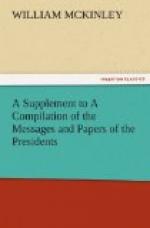GEORGE B. CORTELYOU,
Secretary to the President.
NEWS AT THE WHITE HOUSE.
The official announcement of the President’s death was received at the White House at 2:35 o’clock, September 14, 1901, as follows:
Buffalo, September 14.
Col. B.F. Montgomery, Executive Mansion, Washington:
The President died at 2:15 this morning.
GEORGE B. CORTELYOU.
Immediately upon receipt of the official dispatch the following was sent to Secretary Cortelyou:
Members of the executive staff in Washington
are deeply affected, and
beg to tender their profound sympathy
to Mrs. McKinley.
O.F. PRUDEN,
Assistant Secretary.
PUBLIC ANNOUNCEMENT OF DEATH BY THE PHYSICIANS.
MILBURN HOUSE, Buffalo, N.Y., Sept. 14.
The following report of the autopsy upon the remains of President McKinley was issued at 5 o’clock:
The bullet which struck over the breastbone did not pass through the skin, and did little harm. The other bullet passed through both walls of the stomach near its lower border. Both holes were found to be perfectly closed by the stitches, but the tissue around each hole had become gangrenous. After passing through the stomach the bullet passed into the back walls of the abdomen, hitting and tearing the upper end of the kidney. This portion of the bullet track was also gangrenous, the gangrene involving the pancreas. The bullet has not yet been found. There was no sign of peritonitis or disease of other organs. The heart walls were very thin. There was no evidence of any attempt at repair on the part of nature, and death resulted from the gangrene, which affected the stomach around the bullet wounds as well as the tissues around the further course of the bullet. Death was unavoidable by any surgical or medical treatment, and was the direct result of the bullet wound.
HARVEY D. GAYLORD, M.D.
HERMAN G. MATZINGER, M.D.
P.M. RIXEY, M.D.
MATTHEW D. MANN, M.D.
HERMAN MYNTER, M.D.
ROSWELL PARK, M.D.
EUGENE WASDIN, M.D.
CHARLES G. STOCKTON, M.D.
EDWARD G. JANEWAY, M.D.
W.D. JOHNSON, M.D.
W.P. KENDALL, Surgeon, U.S.A.
CHARLES CARY, M.D.
EDWARD L. MUNSON, Assistant Surgeon,
U.S.A.
HERMANUS L. BAER, M.D.




